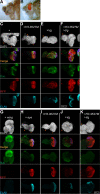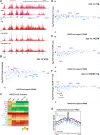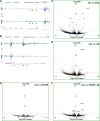The H3.3K27M oncohistone antagonizes reprogramming in Drosophila
- PMID: 34280185
- PMCID: PMC8320987
- DOI: 10.1371/journal.pgen.1009225
The H3.3K27M oncohistone antagonizes reprogramming in Drosophila
Abstract
Development proceeds by the activation of genes by transcription factors and the inactivation of others by chromatin-mediated gene silencing. In certain cases development can be reversed or redirected by mis-expression of master regulator transcription factors. This must involve the activation of previously silenced genes, and such developmental aberrations are thought to underlie a variety of cancers. Here, we express the wing-specific Vestigial master regulator to reprogram the developing eye, and test the role of silencing in reprogramming using an H3.3K27M oncohistone mutation that dominantly inhibits histone H3K27 trimethylation. We find that production of the oncohistone blocks eye-to-wing reprogramming. CUT&Tag chromatin profiling of mutant tissues shows that H3K27me3 of domains is generally reduced upon oncohistone production, suggesting that a previous developmental program must be silenced for effective transformation. Strikingly, Vg and H3.3K27M synergize to stimulate overgrowth of eye tissue, a phenotype that resembles that of mutations in Polycomb silencing components. Transcriptome profiling of elongating RNA Polymerase II implicates the mis-regulation of signaling factors in overgrowth. Our results demonstrate that growth dysregulation can result from the simple combination of crippled silencing and transcription factor mis-expression, an effect that may explain the origins of oncohistone-bearing cancers.
Conflict of interest statement
The authors have declared that no competing interests exist.
Figures







References
Publication types
MeSH terms
Substances
Grants and funding
LinkOut - more resources
Full Text Sources
Molecular Biology Databases

